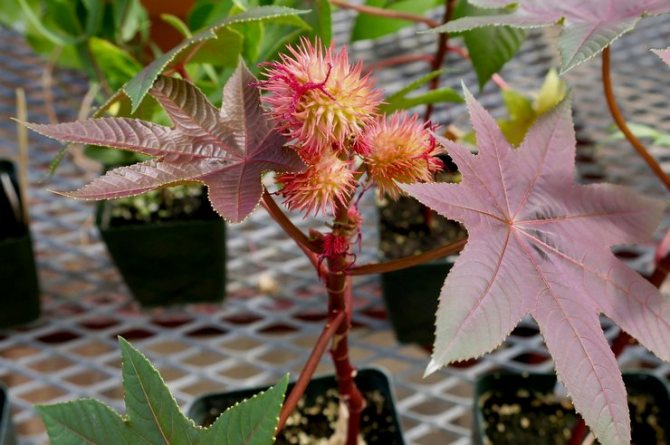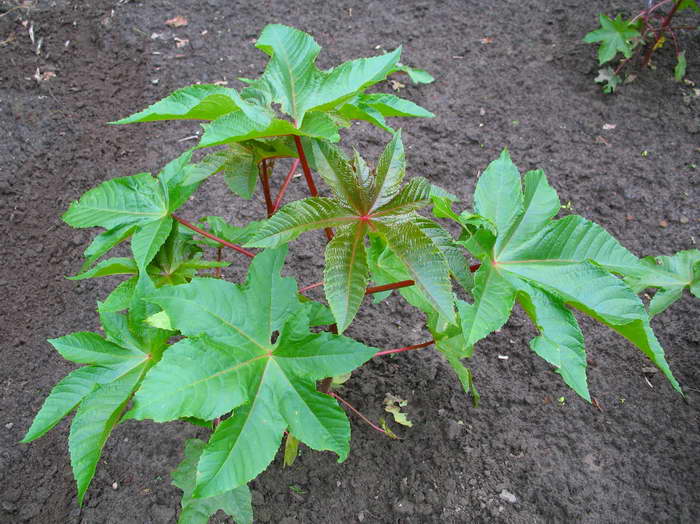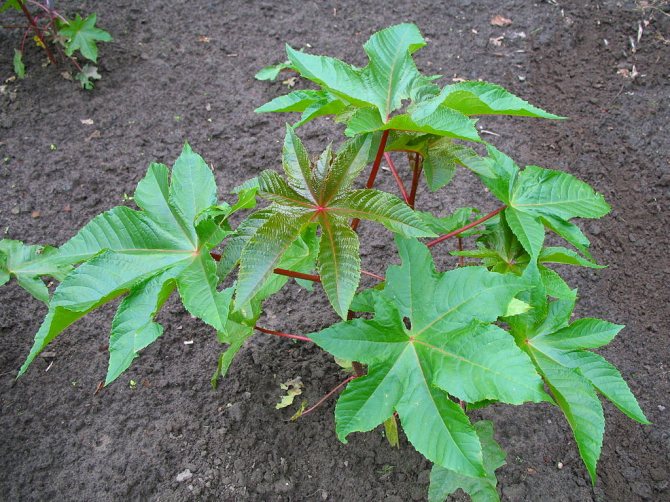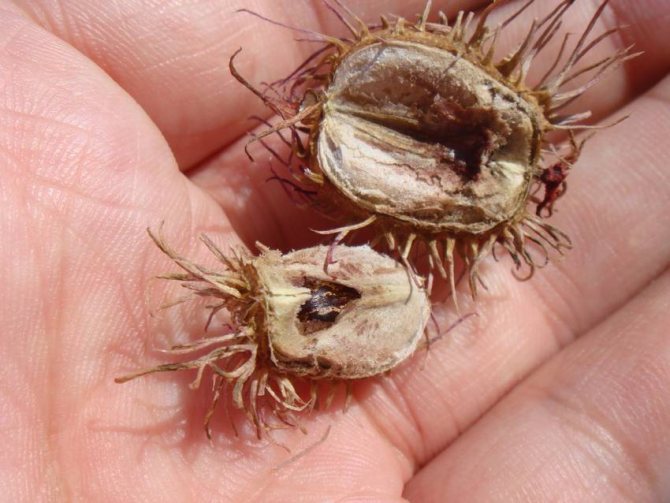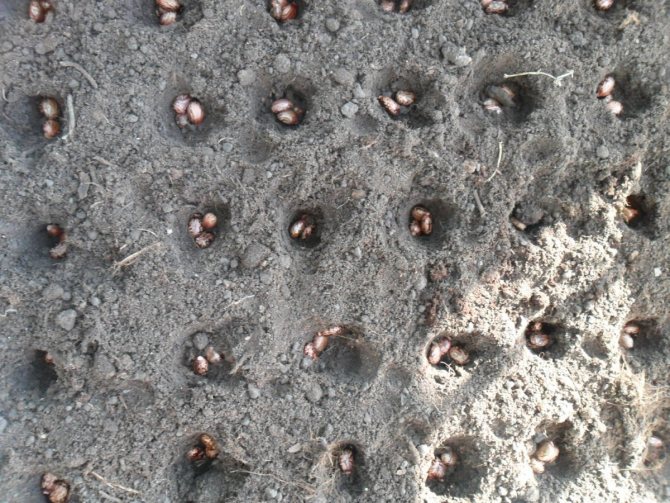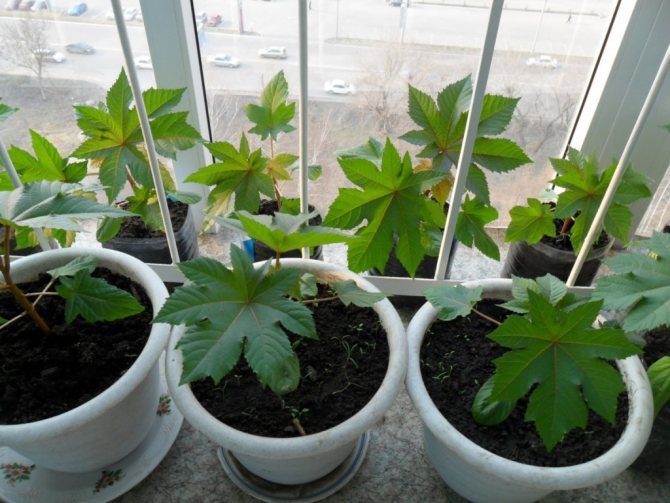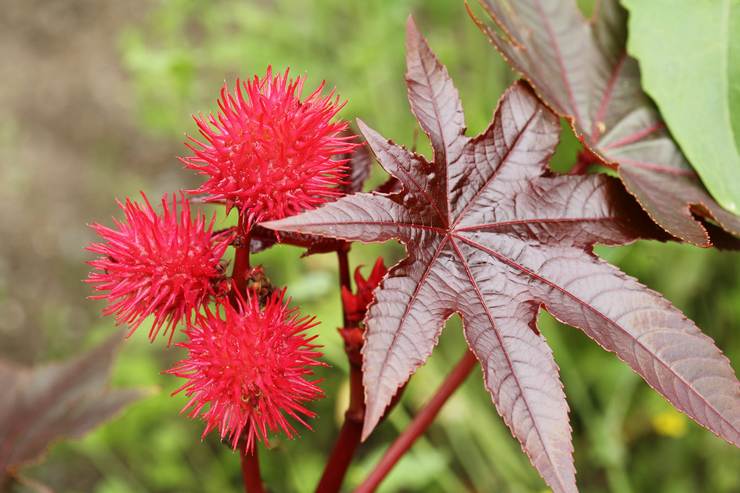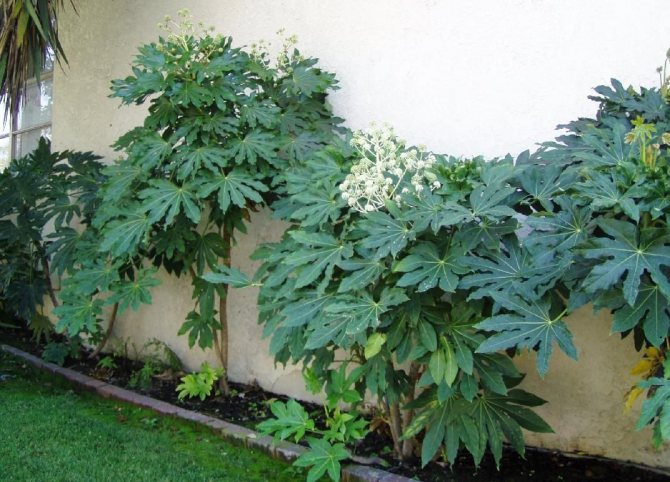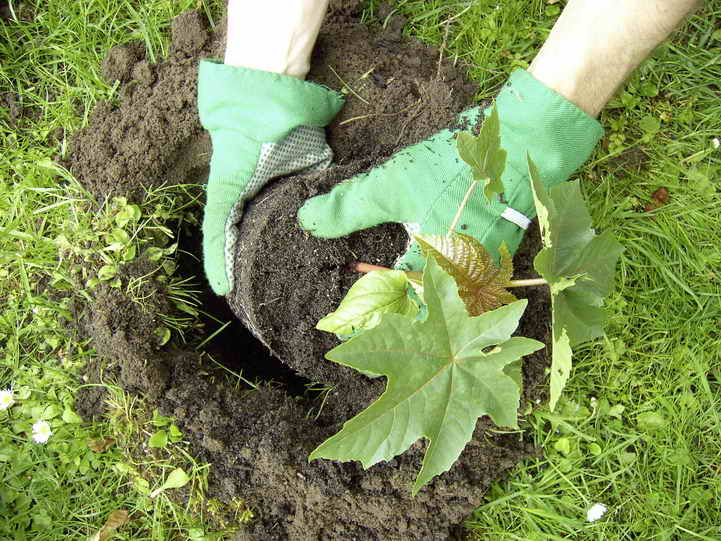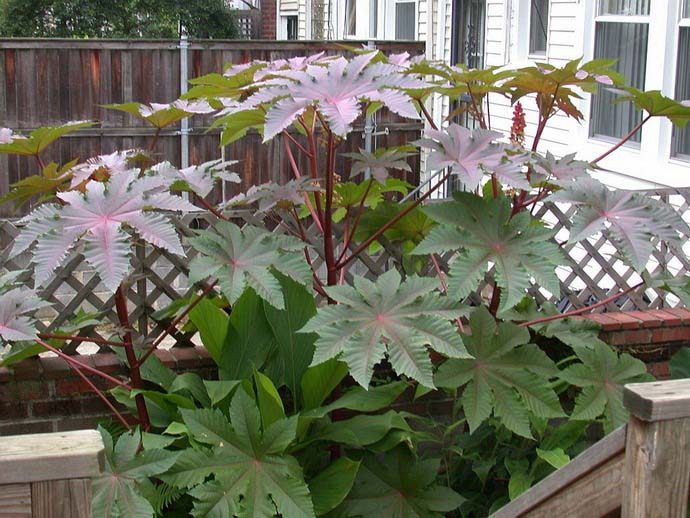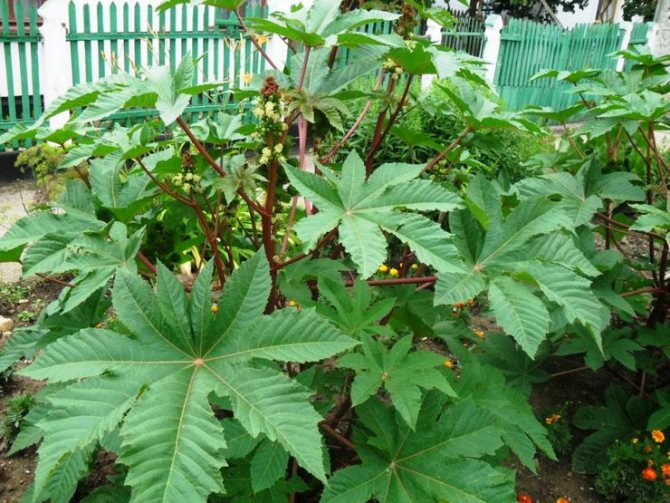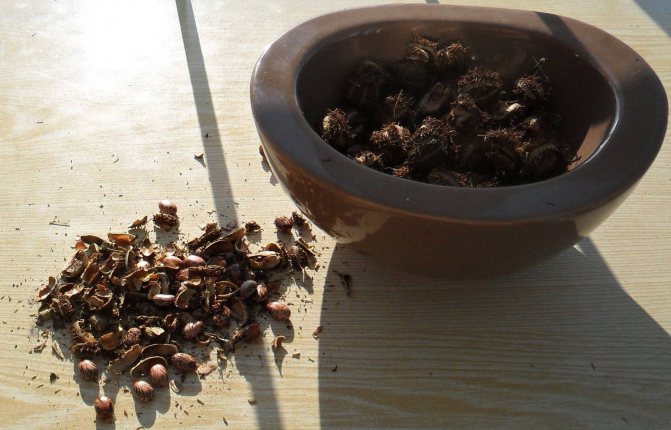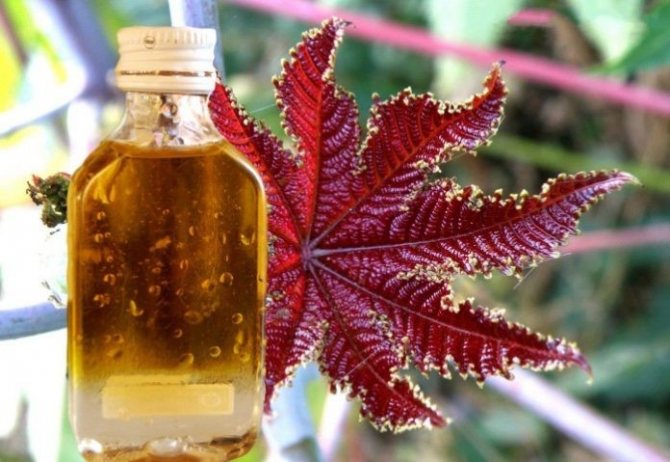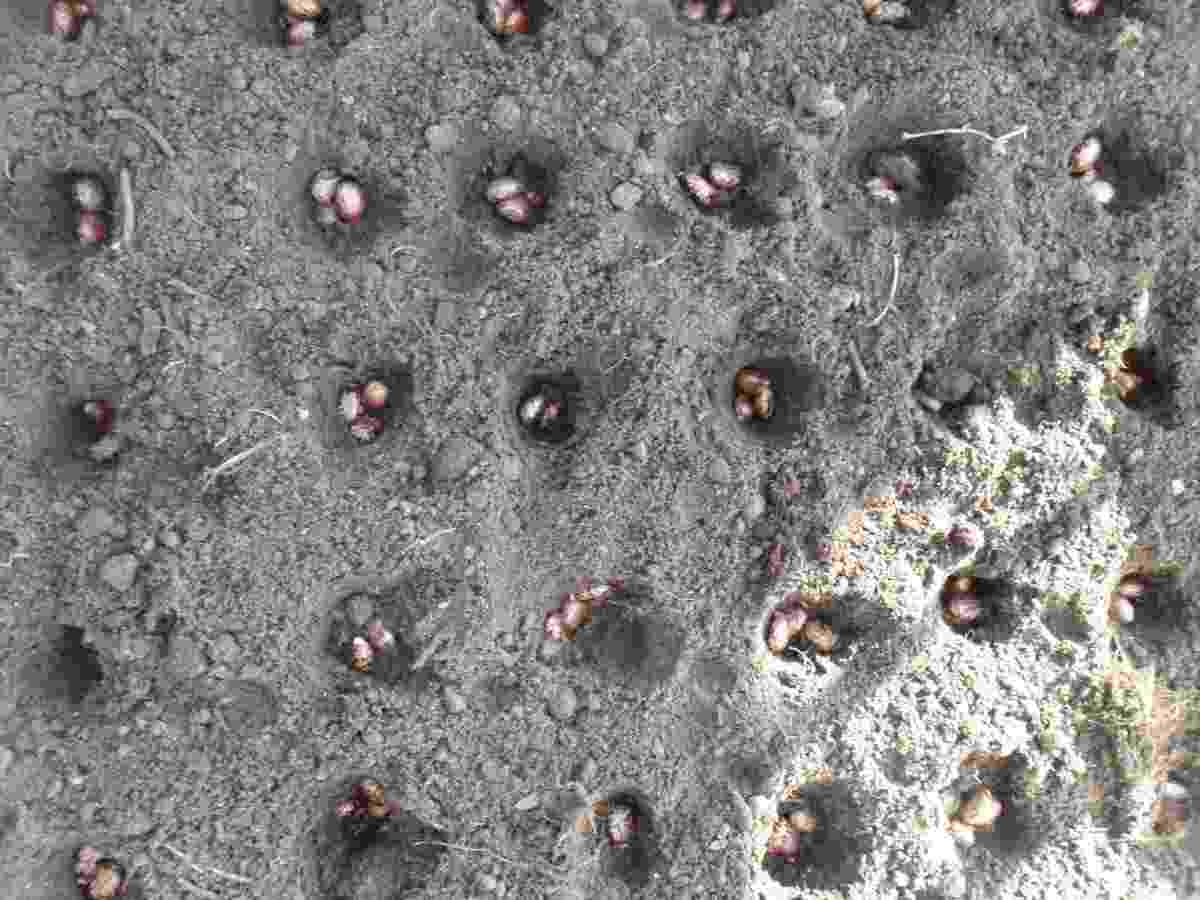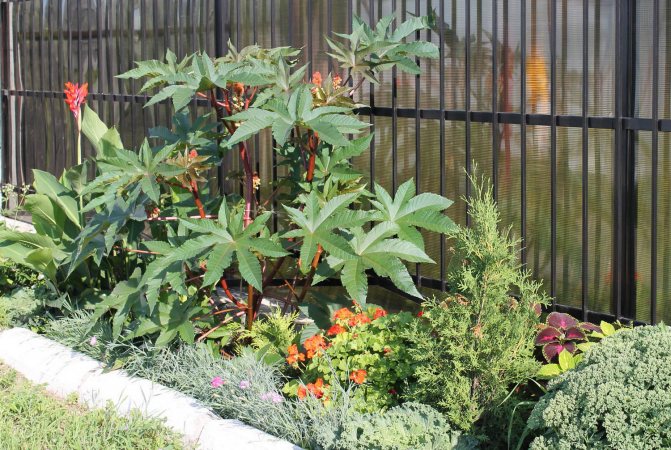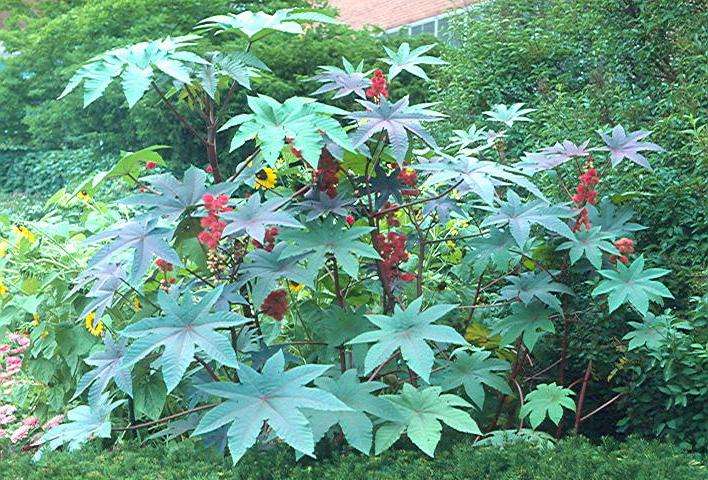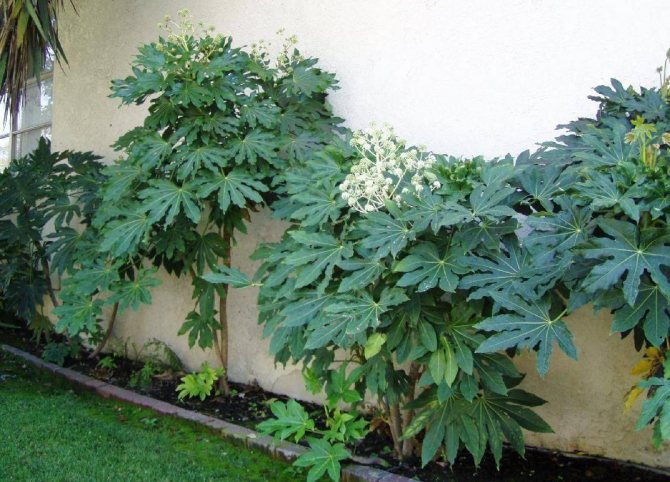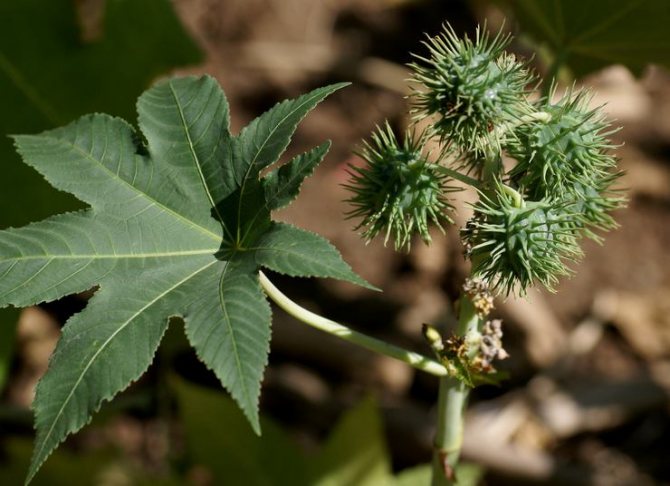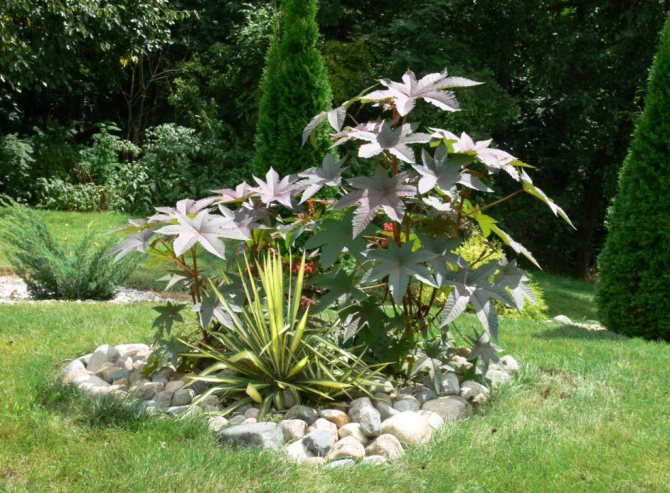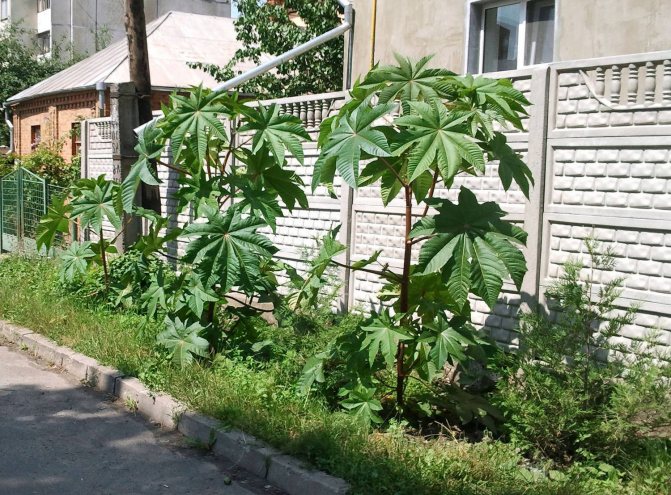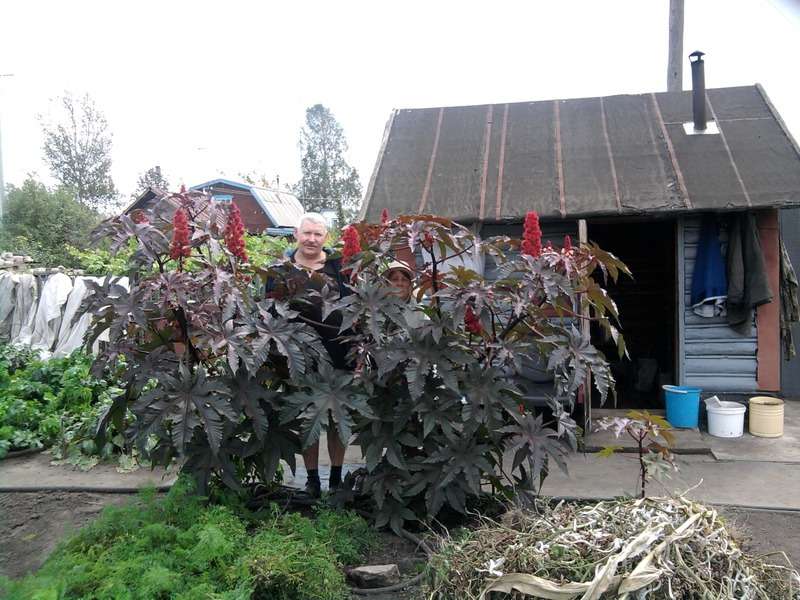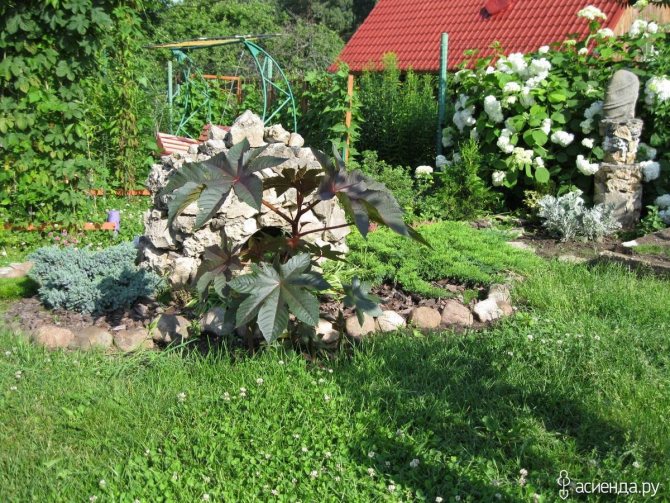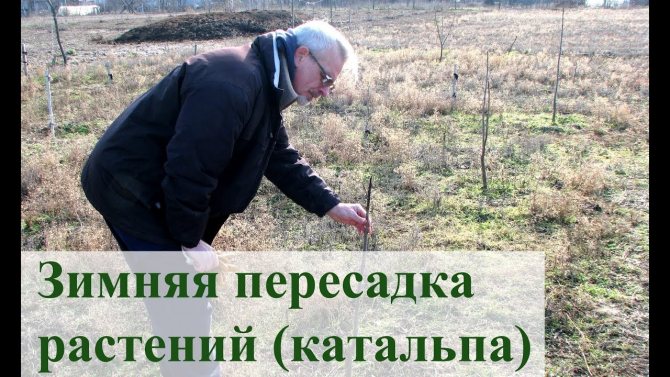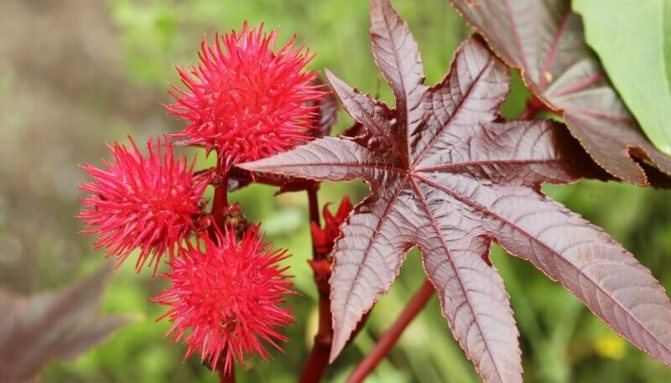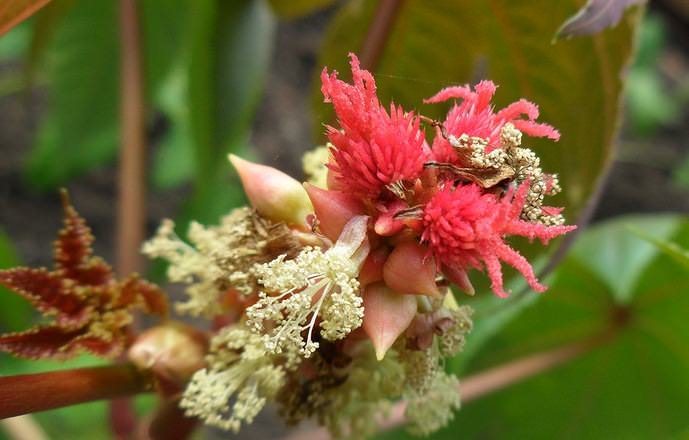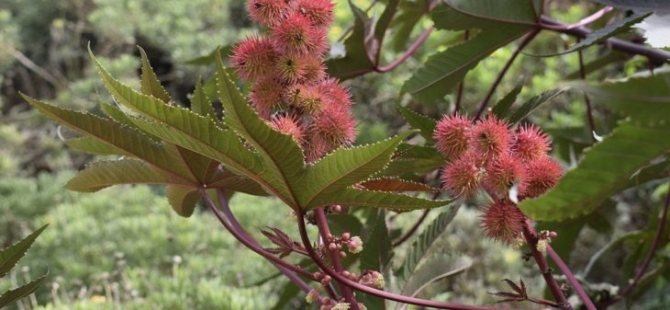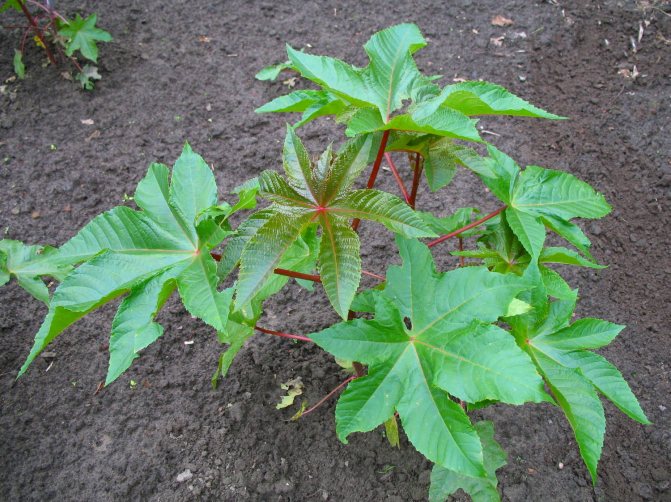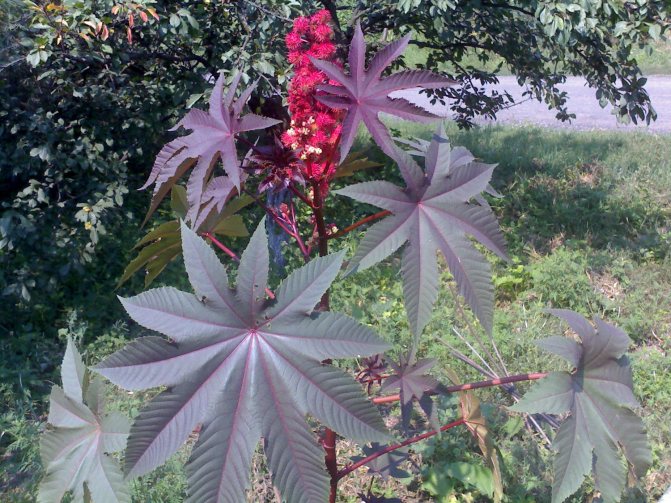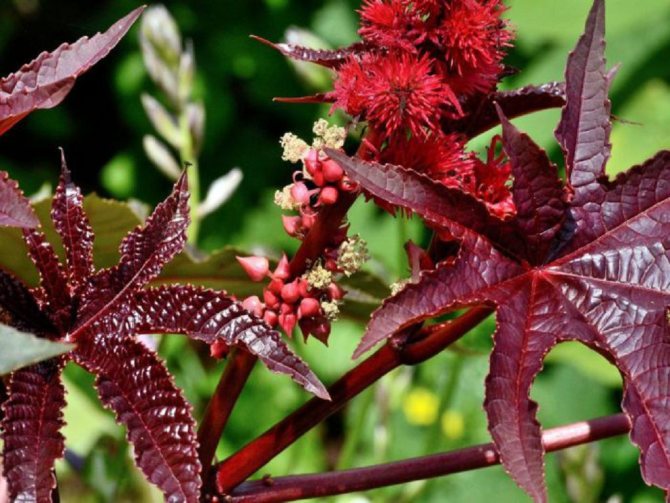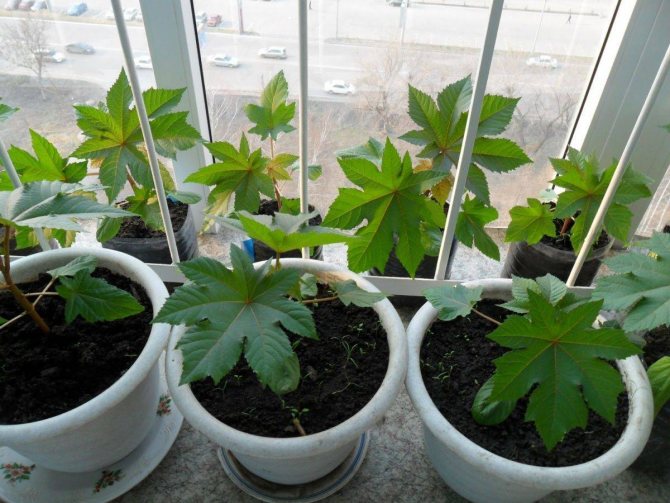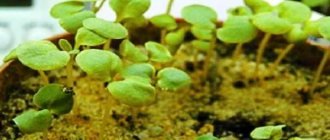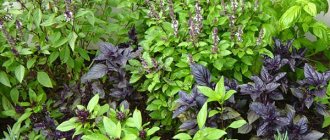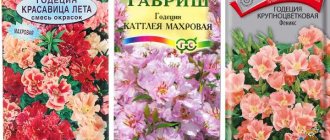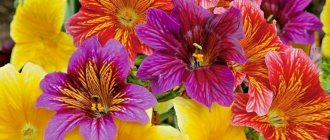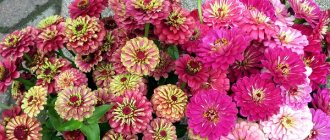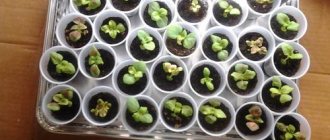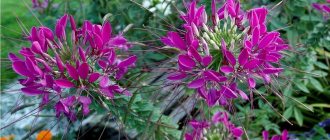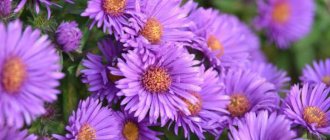Castor oil plant - growing from seeds
The castor bean plant is similar to a palm tree - tall, with large leaves resembling maple trees. In the thorny capsules, seeds ripen, resembling beans, but distinguished by a beautiful pattern, similar to art painting. When the seeds are ripe, the pods dry out. At this point, you can extract the seeds for the upcoming planting.
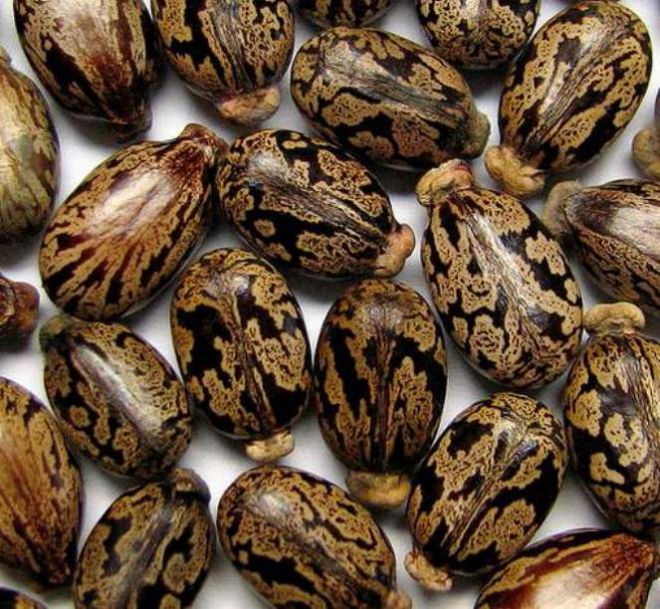
As a tropical plant, castor bean loves the sun and warmth, the soil prefers loose and soft. Cultivating it, remember - this is a poisonous plant! Only its seeds are life-threatening - only seven eaten stuff can become a lethal dose for a child, and twenty for an adult.
The most common types of castor beans:
- Zanzibar;
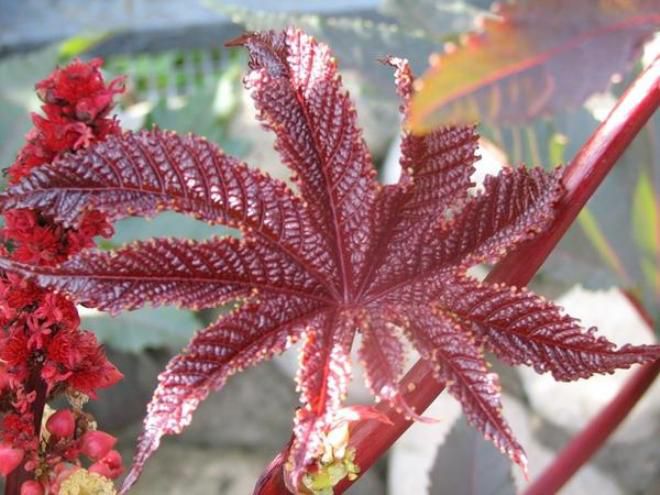

- Gibson;


- Cambodian;
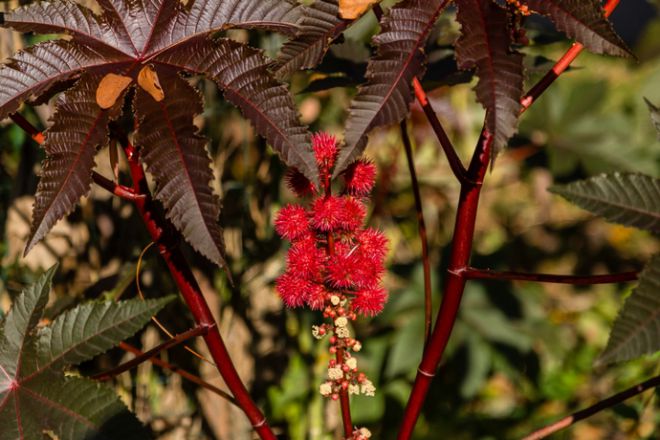

- northern palm;
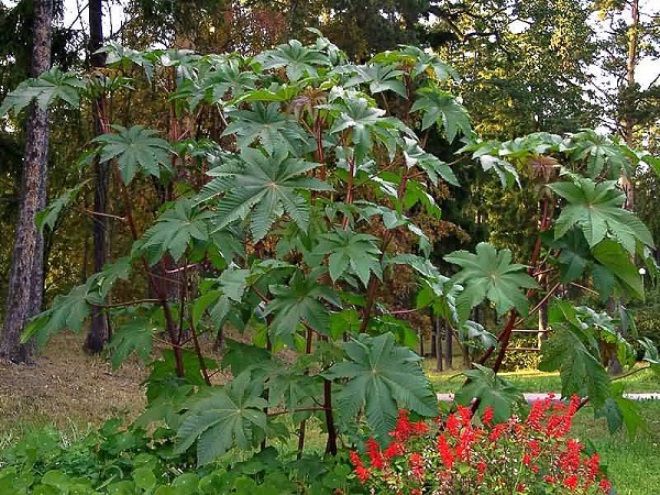

- impala;
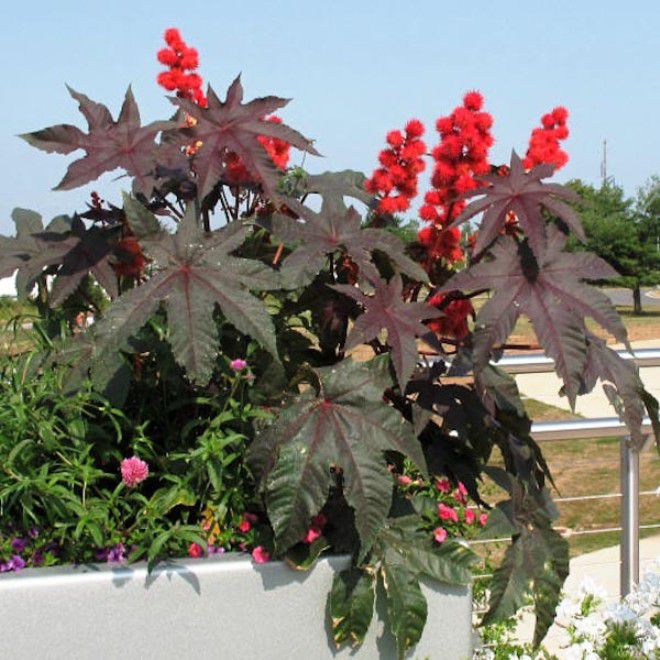

- Cossack.
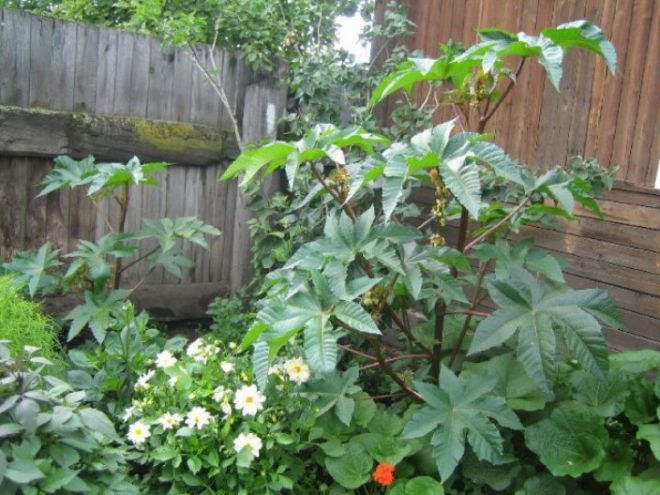

When to plant castor bean seedlings?
Castor bean seeds can simply be planted in the soil, without preliminary manipulations, but in this case, the seedlings will have to wait for a very long time, and no more than 6-7 germinate out of ten seeds. One of the options is to plant castor bean for seedlings at home with further planting of bushes in open ground. When to sow castor oil plants for seedlings is one of the most important questions. The best time to plant seeds in the soil is early April.
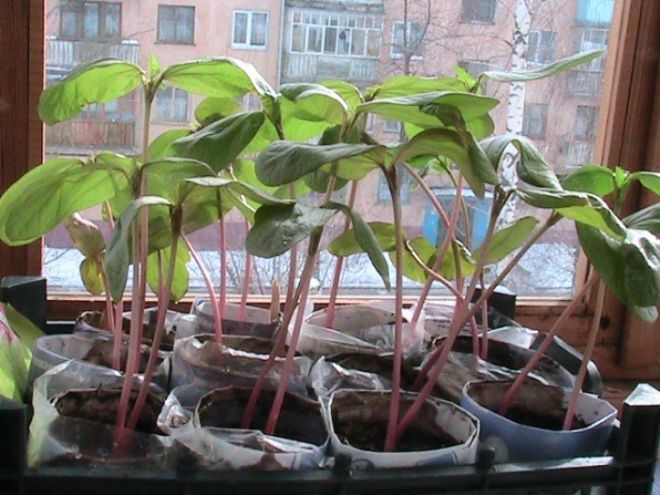

How to germinate castor oil plant from seeds?
We have already mentioned that the germination of castor bean seeds is far from one hundred percent. At home, there is a greater likelihood of good germination, but not much. Do I need to soak castor bean seeds before planting? Yes, this makes sense, if you put the seeds in water for one night, there is a high probability that the water will fall under the shell, and the growth process will begin. This process is called stratification.
For soaking, we take ordinary water, and ideally rain or thawed water, at room temperature. The water should not be cold, pay attention to this. We place the seeds in a container with water, they must be completely covered. There is no need to create special conditions, we just leave them for a day, and the next day we plant them in the soil.
Scarification of castor bean seeds
Scarification is mechanical damage to the hard shell of the seed, it is done so that moisture quickly gets inside the seed, and the growth process begins. This method is widely used for most types of trees and shrubs. Castor bean scarification is done with sandpaper - the seed must be rubbed well. This destroys the hard shell and allows more moisture to penetrate inside. After scarification, the seeds should be soaked as described above, after which they can additionally be placed in water with a growth stimulator.
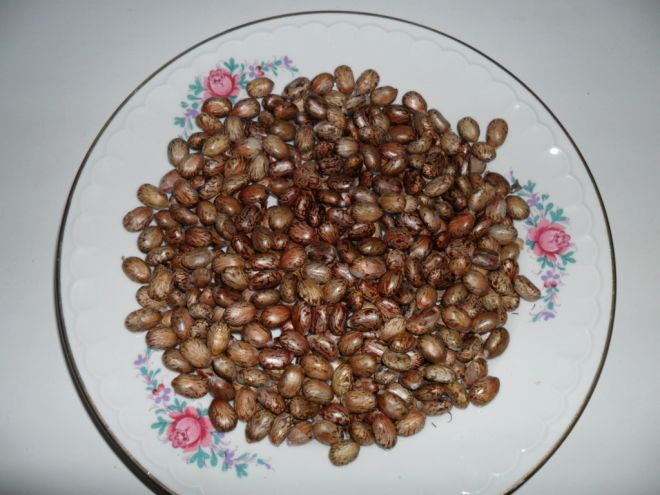

Where is castor oil used?
The benefits and harms of castor beans are unequal. It is used as a laxative and to facilitate childbirth (it perfectly stimulates the muscles of the uterus, thus causing contractions), to treat burns, ulcers and other wounds. However, the castor bean plant itself is poisonous.
Castor oil, which is obtained as a result of processing the fruits of this plant, has a truly unique property - it does not freeze at low temperatures and does not dry out.That is why it is so effective in the treatment of skin lesions, as well as as a lubricant and impregnation material in production.
The seeds of the plant, which were collected recently, still retain a certain amount of poison in themselves, therefore, as a rule, only old seeds are used for the production of castor oil.
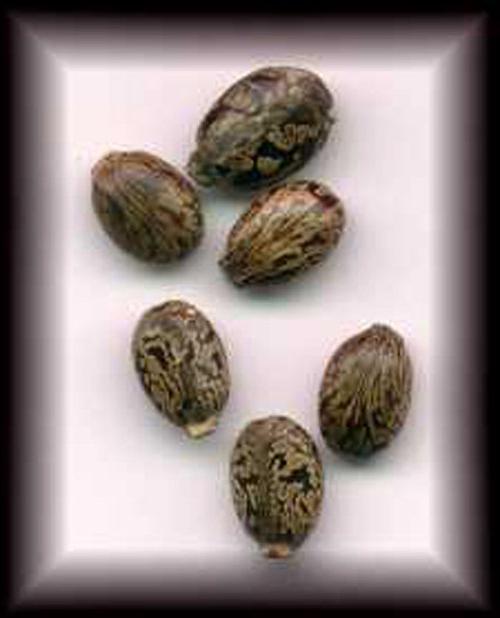

What else is castor oil useful for? What is castor oil commonly used for? In particular, it is the castor bean product that can help with:
- rheumatitis and arthritis (use as a compress);
- deteriorated condition of hair, eyelashes and eyebrows (promotes rapid growth and reduction of hair loss);
- bronchitis and obsessive cough (in combination with turpentine in a ratio of 2: 1 is used for rubbing);
- inflammation of the female organs (compresses to the abdomen);
- calluses, corns and warts (rub oil on problem areas).
Castor oil planting and care
If the planting of castor bean seedlings was carried out correctly, by June you should have small but strong bushes, ready for planting in open ground. Before planting, the plant should be well watered several times so that the entire clod of earth is well wet. The fact is that, for all its unpretentiousness, the castor oil plant is very afraid of transplanting - the slightest damage to the roots can destroy it, so it should be removed very carefully.
First, we prepare a hole in the ground, remove the plant from the pot along with a lump of soil and, without shaking off the earth, place it in open ground. We fill the castor oil plant with earth, tamp it and water it abundantly. If the root system is not damaged, the plant will adapt very quickly. An adult plant in care is very unpretentious and requires almost no attention.
What is the care of castor bean grown from seeds - in the timely removal of weeds, which at first may interfere with its growth. But even this problem can be easily solved once by mulching the soil. The only thing that should be provided for the castor oil plant in the garden is regular and abundant watering.
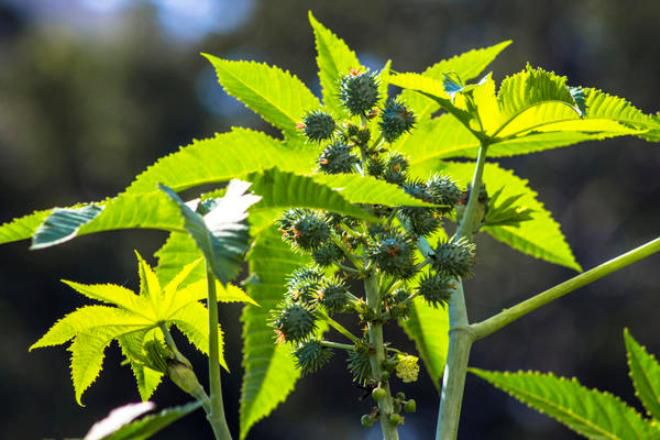

How to plant castor oil plant from seeds?
Consider another option for how castor oil plants are planted - growing from seeds, when to plant them in open ground, and how to do it correctly. Let's decide on the timing - it should be a warm spring, when you are sure that there will be no more cold snaps. This is done closer to mid-May. Planting seeds in open ground is not very different from instructions on how to properly plant castor oil plants on seedlings - you should first rub them with sandpaper, soak them in water for a day, and then in a growth stimulator.
When planting seeds, take into account their low germination capacity. In each hole it is worth placing 2 large good seeds or three medium ones. If several sprout up, the weaker shoots can be removed immediately. So that the seeds in the soil do not suffer from the cold, the first days after planting it is worth covering the crops with foil at least overnight.
How much castor oil plant grows?
Castor oil plant, if it was grown from seeds directly in the soil, rises at different times, depending on when to plant, on compliance with the rules for preparing seeds for planting, and on the air temperature. If the weather is already warm, there are no cold snaps at night, and the first days of sowing were carried out under a film, then it is not difficult to predict how many days the castor bean rises - normally it is 7-10 days.
Selection and treatment of seeds
It is necessary to grow castor oil plant using large seeds, which have a convex and painted surface. After sowing, they quickly germinate and produce true leaves.
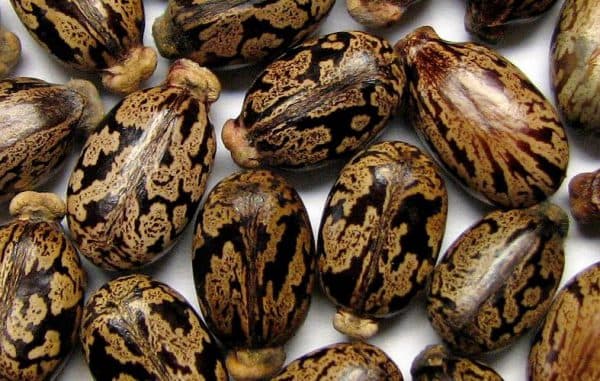

This plant reproduces exclusively by seeds. It is recommended to stratify them before planting.
Castor bean seeds have a very low germination rate. Six of a dozen will germinate at best 6. To increase the likelihood of sprouting, the seeds can now be sandpaper and soaked overnight in a growth stimulator.In principle, this crop can be sown directly into the ground, but the best results can be achieved precisely through propagation by seedlings.
If you have previously scarified the seeds, then the first shoots may appear after 3-4 days.
Castor oil plant: growing from seed. When to plant?
In the ennobling of a summer cottage or backyard territory, castor oil plants are especially successful. This exotic-looking plant got its name from the seeds similar to mites. Among the people, you can hear other names for it: paradise tree, Turkish hemp or castor oil. The castor oil plant is interesting for its huge maple-like leaves attached to long stalks.
In our latitudes, the paradise tree does not grow higher than three meters, although in the zones of natural growth it can reach ten. A hedge or a central element in decorating a land plot is created from it. The castor oil plant has no chance of surviving the harsh winter, so unlike the Africans or the Chinese, we have to grow it from scratch every year. The only way to ensure that the castor oil plant flaunts on the territory you need is growing from seeds. Learn how to plant and care for Turkish cannabis so that it is pleasing to the eye in this article.
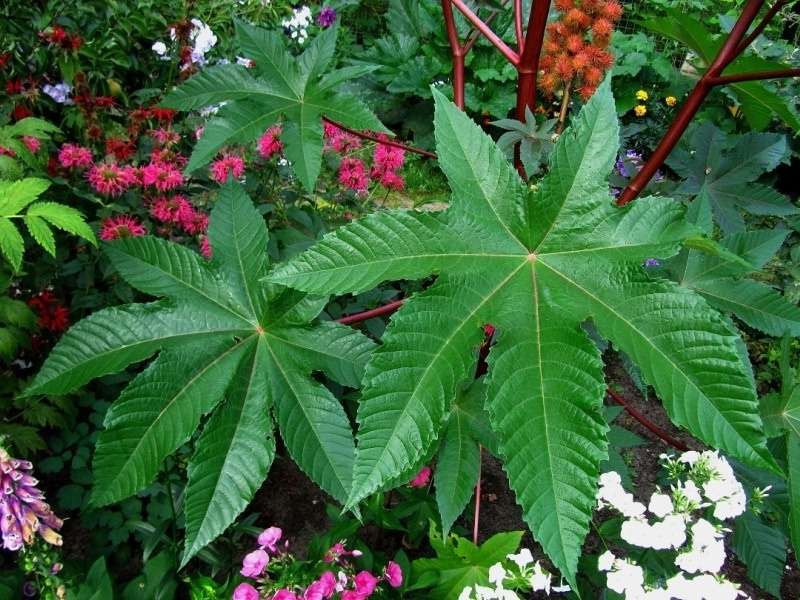

Plant features
This plant was already known in ancient times. This fact is proved by the seeds found during excavation of tombs.
The name castor oil plant (its benefits and harms will be discussed in the article) got thanks to the Romans, who compared it with a tick. Other names that are less popular, but still exist - Christ's palm and castor beans (everyone knows about the healing properties of castor oil).
The castor oil plant is famous for its beautiful and spreading bushes. Some are up to 3 m in height. The color of the stems is usually brown, green or red. The leaves are rather large in size, located on long petioles. Their color is also atypical for plants - dark red with a tint of green. The castor oil plant has a more attractive appearance with a single planting.
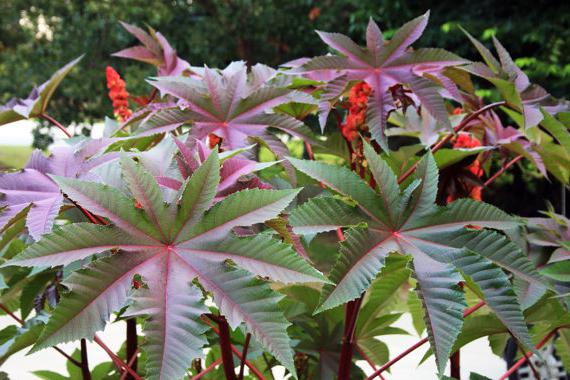

In the summer, the castor bean begins to bloom, after which you can see fruits, the shape of which resembles hedgehogs.
Growing castor bean before planting in open ground
In order for castor oil plant to become a worthy decoration of a certain territory, you will have to work a little: collect or buy seeds, prepare them for planting, choose a suitable site and create the right conditions for growing. Caring for an undemanding tree paradise will not take much work. If desired, you can grow castor oil plants from seedlings, then it will have time to reach a greater height.
Collecting seeds Many growers have come to the conclusion that it is much easier to grow castor oil plants from seeds collected with their own hands than from purchased ones. To get ripe seeds, you need to cut off the inflorescences on the bush, leaving only one. The seeds will need to be removed from it just before the frost. They are stored in a dry place during the winter.
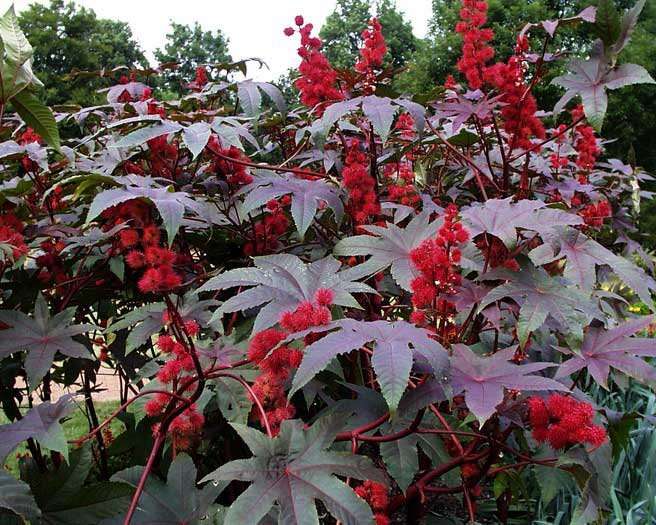

Seed preparation Paradise tree seeds do not germinate well - 10 seeds usually grow to 5 or 6. To increase the chances of getting more sprouts from mite-like seeds, they need to be specially prepared. To do this, perform the following actions: • carefully sort the seeds, leaving only large, dense and smooth; • perform scarification by rubbing the seeds with sandpaper; • Soak the seeds in water for a day, or better for 12-14 hours in a growth stimulator.
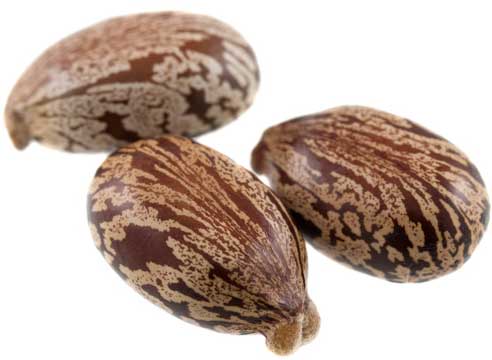

Castor bean seed looks like a tick
Substrate preparation For growing castor bean seedlings, you can use several options for substrates: • a mixture of sod land, leafy soil and humus, • pre-harvested land from the garden, • special purchased soil, • peat pots.
Castor oil plant does not like transplants, so the seeds are planted immediately in separate containers.Given the size of the sprouts that will be transferred to the open ground, the volume of each pot should be at least three liters. Be sure to make drain holes in them. Make sure that when the time comes to plant the shoots in a permanent place, it is possible to extract the roots of the plant from the container along with a whole earthy clod.
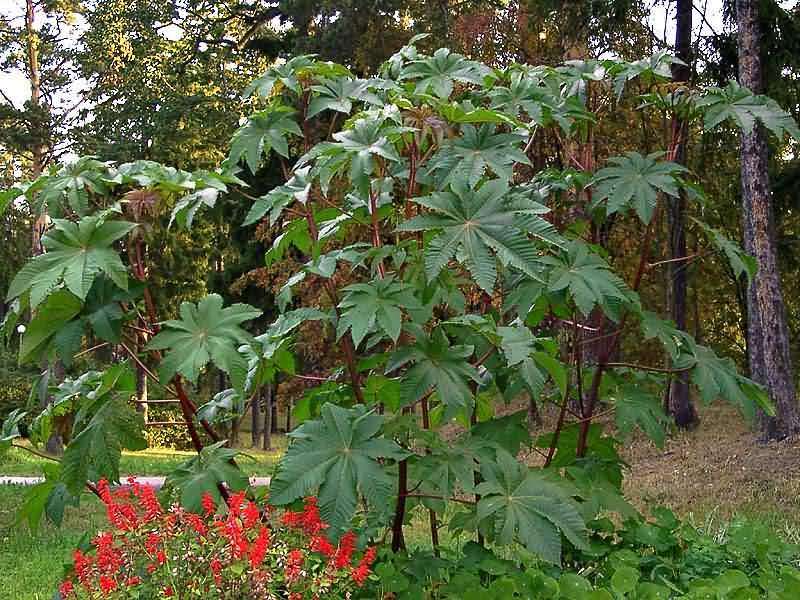

Planting seeds Castor bean seeds are planted in a greenhouse, usually in March. Two or three seeds are placed in each prepared container. Subsequently, the weakest of them can be cut or left to create the most lush bush. At first, the container is half filled with the substrate, and then, as the plant grows, it is poured to the top. You need to plant seeds to a depth of one and a half to two centimeters. They need enough light and moisture to germinate.
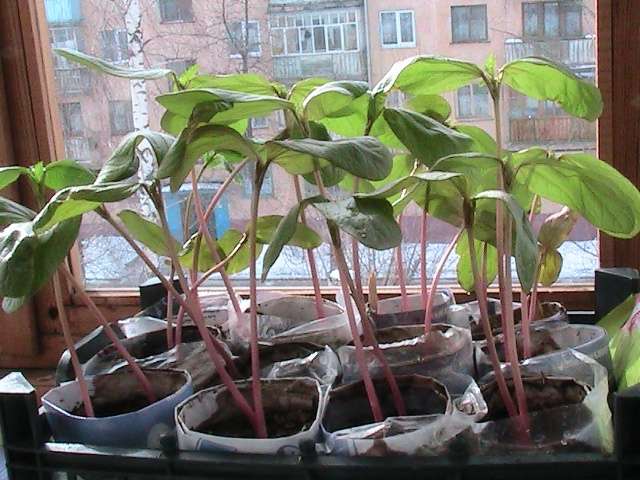

Castor bean sprouts are immediately planted in separate containers
Growing seedlings Seedlings will have to wait at least five days. In order to avoid decay, it is necessary to remove the sticky peel from the cotyledonous leaves that have appeared. To do this, you can use tweezers or a dry cloth, after sprinkling with water from a spray bottle. After the appearance of a real leaf, you need to try to create the following conditions for the seedlings: • temperature about 15 ° C, • bright sunlight, • abundant watering, • turning from opposite sides to the sun, • gradually adding substrate, • creating support (if necessary).
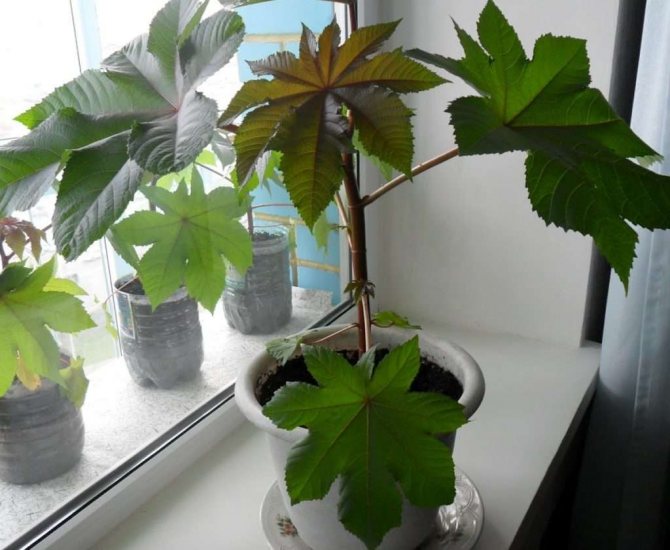

Castor oil plant is very poisonous
Important! Castor oil plant is a poisonous plant, and edible crops growing next to it become the same.
Reproduction
Palm trees propagate by seeds. But there are certain peculiarities here:
- The grains are covered with a dense shell, so they germinate for a long time. They will be planted for seedlings in early March.
- Before planting, the planting material must be held in warm water for 24 hours. In this case, the liquid should be changed periodically.
- Plant the plants to a depth of 1-2 cm. This will require large peat cups. They should be placed in clay pots. Such measures prevent damage to the roots during plant transplantation.
- After planting, cover the seedlings with foil for 7 days. Keep the container at a temperature of 15 degrees.
- After 7 days, you can transplant the container with seedlings to a permanent place. After 3 weeks, the first shoots are formed.
How to plant seeds or plant castor bean seedlings outdoors
Choosing a suitable place It is important that the area that you define for planting castor oil plants is not located very close to fruits or vegetables, so that they do not absorb its poisons. For each bush from one sprout of a spreading paradise tree, it is necessary to leave at least one square meter of land, for a bush of several sprouts - one and a half. The castor oil plant should be planted in an area that is well lit by the sun, but protected from the wind. In light shade conditions, the leaves will not develop a beautiful red tint.
Sowing seeds in open ground For planting in open ground, the seeds must be prepared as described above. Even a slight frost may not tolerate castor oil plants. Growing from seeds (when planting in a greenhouse is described above) in the open field is recommended to start closer to the end of May or at the beginning of June. They are able to germinate at a temperature of at least 10 ° C. The action plan is as follows:
- moisten the earth well,
- dig shallow holes,
- put two or three seeds in them,
- bury a hole
- water again.
Contraindications for use
Unequal if castor oil plant is used, the benefits and harms. Reviews are proof of this. Despite the fact that castor oil is a natural product, there are some contraindications to its use. Knowing about them, you can avoid many unpleasant situations.
Castor oil must not be used for:
- poisoning with alcohol, benzene and other similar fat-soluble substances;
- allergies;
- diseases of the stomach and the entire gastrointestinal tract.
Remember that castor bean seeds contain a substance called ricin, which contains a certain amount of cyanide. That is why you need to be extremely careful with this plant, and if seeds enter the body, you need to provide first aid (induce vomiting and rinse the stomach) and immediately call doctors.
Botanical description
Castor oil plant (Ricinus communis) - is a perennial spreading shrub 2-10 m high. "Ricinus" is translated from Latin as "tick", hence the name "castor oil plant". The plant is also called paradise tree, castor oil, Turkish hemp.
The stem is glabrous, erect, branched, colored brown, red or bluish-green. The leaves are of decorative value. They are large, finger-divided (consisting of 5-7 lobes), attached on long hollow petioles. The segments are oval in shape, have a pointed apex and wavy edges. The width of the sheet plate is 30-80 cm.
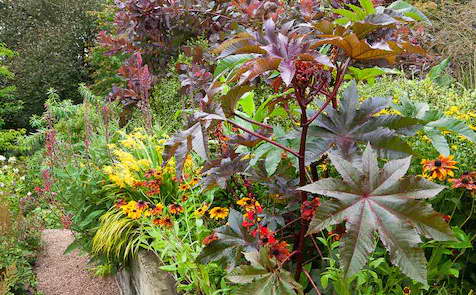

Castor oil plant in landscape design photo
The color of the leaves is green, the veins are pronounced. Flowering: dense racemose inflorescences, consisting of small whitish flowers. After flowering, fruits appear in the form of spherical-oval bolls covered with thorns. The diameter of each ball is about 3 cm, they are located between the leaves in several pieces, giving attractiveness. Oval-shaped seeds have a variegated mosaic color: against the background of the main color (gray, red-brown, etc.) there are patterns of brown, black, pink, pale pink.
Oil plant, has medicinal properties, grown as a garden crop. Belongs to the Euphorbia family and is the only member of the genus with several forms and varieties. Africa (namely Ethiopia) is considered the birthplace of castor bean, but in the natural environment it can often be found in the subtropics, tropics of India, Brazil, Argentina, Iran, China. Castor bean seeds were found in the tombs of the kings of Egypt - the Egyptians cultivated the culture for more than one millennium.
How poisonous is castor oil plant
Be careful as all parts of the plant are poisonous (contain alkaloids). Variegated seeds should never be eaten. If a child eats about 6 seeds, and an adult - up to 20 seeds, a lethal outcome is possible. Signs of poisoning include headache, weakness, nausea, vomiting, stomach discomfort, and the skin may turn yellowish. In this case, you should immediately consult a doctor. All work with the plant is carried out with gloves, wash your hands thoroughly with soap, do not allow children and animals to come into contact.
Gardeners reviews
Tanich, St. Petersburg
And in general, in April I will plant it now. Taught by bitter experience. I have it so rushing on the windowsill, and when it comes time to plant it in the ground, it is already very large and it hurts with sweat and slows down in growth.
Hel, Moscow
If water is near (and this year they are almost everywhere close), then it grows poorly upward and almost does not turn red. I also grew no more than 60 cm, but red. There is another answer: castor bean is different - red (because of its decorativeness, they buy it, mostly) and green (which is sometimes slipped into the seeds instead of red).
Castor oil plant from seeds at home
Castor bean seeds photo
The plant propagates exclusively by seed.
How to collect the seeds of the tree of paradise
To collect the seeds, it is necessary to pick the fruits before the onset of cold weather (at the beginning of September). Spread them out on paper in a well-ventilated area to dry. In December, you can extract seeds from fruits. The seeds germinate for about 4 years, but due to their toxicity, they must be stored carefully: in an inaccessible place for children and animals.
You can sow directly into open ground or grow seedlings.
When to sow castor oil plant in open ground
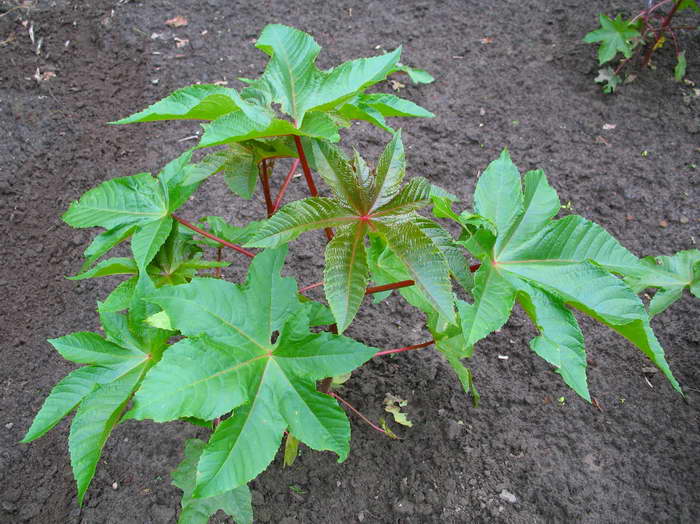

How to plant castor bean seeds in the ground photo
Sowing in open ground is carried out at the end of April-May, when the soil warms up to 12 ° C. Dig up the area, make holes at a distance of 1-1.5 m and place 2-3 seeds in each, press the soil a little, water.
Growing seedlings
As soon as the planting material has been prepared, then it should be sent in separate cups or peat pots. To deepen the grains to a level of 1-2 cm.
Since the seeds are large in size, it is worth choosing large containers for planting. This will help with further transplantation of plants into the open groove. Thus, it will be possible to save the root system from damage.
Cover the containers with planting material with foil and place them near the window. The temperature regime should be 15-17 degrees. As soon as 7 days have passed, the containers can be taken out into the light. The first shoots can be seen in 3 weeks. Before you need to send seedlings to open ground, it is worth performing full care of the plant. It consists of the following:
- Watering. Moderate soil moisture is required.
- Sunlight. It should be complete, but not direct. This will allow the crown to be healthy, but not elongated.
- The temperature regime should be room temperature.
- Drafts are not allowed.
Castor bean care in the garden
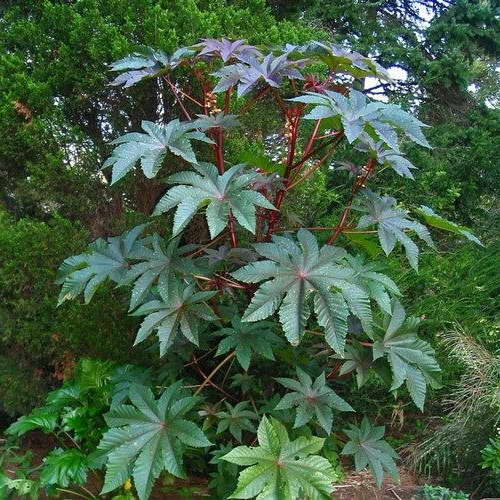

Zanzibar castor oil plant in landscape design photo
- Castor oil plant is unpretentious in care: you only need a suitable place, regular watering, one-time feeding.
- Find a sunny, warm place for the caster.
- The soil is necessary nutritious, loose, black soil is ideal.
- Water the castor oil plant in a timely manner: pour 10 liters of water under the bush every 5 days.
- Weed young plants from weeds, loosen the soil.
- Before flowering, apply complex fertilizers for decorative deciduous plants.
General information
In the modern world, castor bean is considered a highly ornamental plant with many garden forms and varieties, spread far beyond the natural zone - right up to the UK. However, along with its extraordinary beauty, castor oil plant also has an important negative quality - toxicity.
Absolutely all parts of this plant are poisonous, especially seeds that contain ricin in an amount of 0.1% or more. The castor oil plant is so poisonous that it is enough to eat 6 of its berries to cause very serious damage to the body.
Diseases and pests
Occasionally, castor oil plants can be affected by such diseases:
- pink, gray, black rot
- bacteriosis
- cercosporosis
- phyllosticosis
- late blight
- powdery mildew.
Treat with Bordeaux mixture or fungicide.
Castor bean seedlings attract various pests: wireworms, false insects, sandy slugs, meadow moth caterpillars, winter moths. It is better to take preventive measures by treating the wells with a weak solution of potassium permanganate before planting. During the flowering period, meadow bugs may appear on the peduncles. Planting nearby spicy herbs (dill, parsley, garlic, onion, coriander, mint) will help protect against pests. In extreme cases, treat with an insecticide.
How to properly care for a flower
In the right place for the plant, it is much easier to care for it. The following points are important: proper watering, maintaining the soil in good condition, fertilizing and preventing disease.
Rules for watering and feeding the plant
It is customary to water the castor oil plant often. She does not like drought, especially during the flowering period. At this time, you can pour it with a bucket of water every morning.
Fertilize well with organic fertilizers before planting in the ground. It is necessary to dig a hole up to 40 cm deep, lay manure on its bottom. A plant is planted on top. When the time comes before the formation of inflorescences, it is good to add nitrogen.
When a brush of a flower is laid, potassium-phosphorus fertilizers are applied. It is also useful for castor bean to sprinkle the soil with ash.Throughout the summer, once every two weeks, it can be fed with fertilizer for flowering plants.
Features of soil care
The castor oil plant develops quickly, in a year it can grow up to two meters. The composition of the soil must be well cultivated, loose and with sufficient nutrients. Soil - gray or black soils containing sand and clay are not suitable.
It is especially important when planting seeds to ensure that the soil is sufficiently loose.
For planting, soil is made up of equal parts of humus, sod and leafy soil. But you can prepare land from the garden or take purchased land for seedlings.
Prevention of pests and diseases
Castor oil plant does not like weeds, it is especially worth fighting with them while the plant is still young. At an immature age, castor bean is difficult to overcome weeds on your own.
As for pests, they do not affect castor oil plants. Therefore, it is not required to treat the plant with any chemical preparations. But diseases can affect the castor oil plant. To prevent their occurrence, plant seeds must be collected from healthy crops, cleaned and etched. During the growing season, the plant is sprayed with 1% Bordeaux liquid or similar preparations.
The best varieties and types of castor beans with photos and names
In nature, there is only one type of plant - castor oil plant, but numerous varieties have been bred for decorative purposes.
Castor oil plant zanzibar Ricinus zanzibarinus
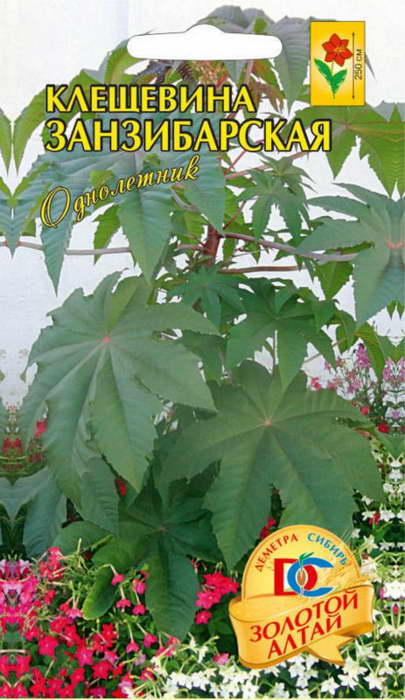

Castor oil plant zanzibar photo
An annual plant about 2 m high. The leaves are huge, palmate-divided, colored in a red-violet hue.
Castor bean Cambodian or Indian Ricinus cambodgensis
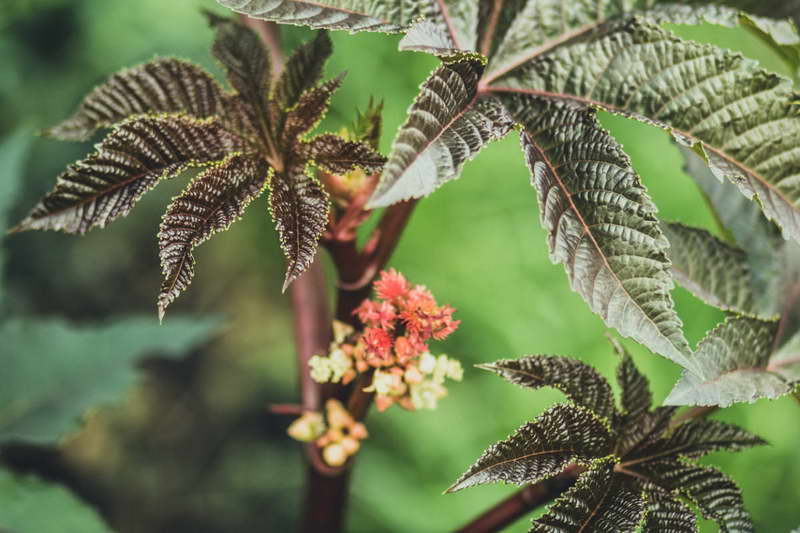

Castor bean Cambodian or Indian Ricinus cambodgensis photo
Reaches a height of 1.2 m. The trunk has a dark, almost black color. Dark green leaf plates are deeply dissected into lobes.
Castor oil plant Ricinus gibsonii
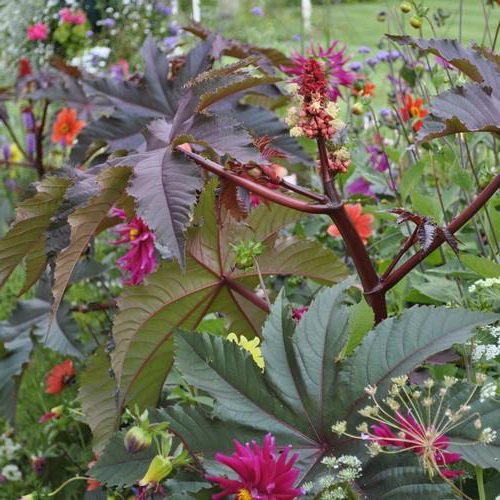

Castor oil plant Gibson ricinus gibsonii photo
Low compact bushes about half a meter in height. The color of the leaf plate is dark green, the veins have a burgundy hue. The leaves have a metallic sheen. Available in purple-colored varieties.
Castor oil plant red
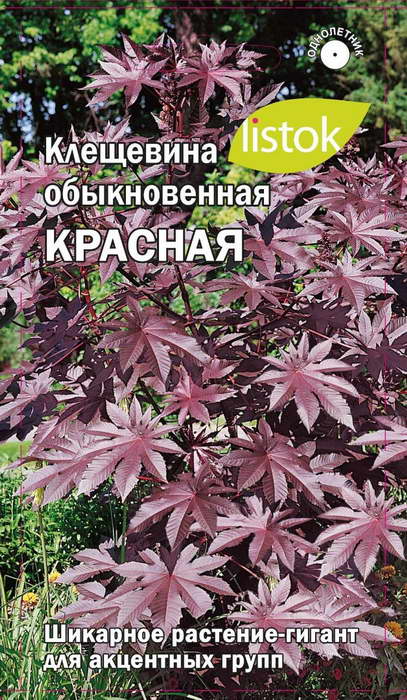

Castor oil red photo
The height of the bush is 1.5-2 m. Large, palmate-separated leaves are shiny and have a dark red color.
Castor oil plant impala Ricinus Communis Impala
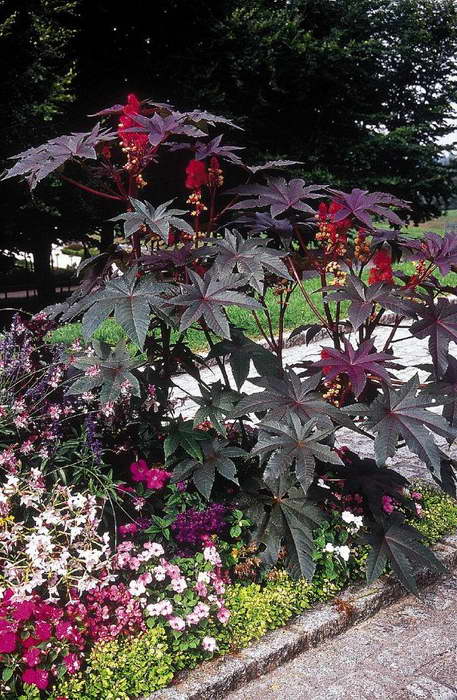

Castor oil plant impala Ricinus Communis Impala photo
The plant is 1.2 m high. The leaf plates are painted in a bronze-green hue, the veins are reddish. Large dense racemose inflorescences consist of bright red flowers.
Castor oil plant Ricinus borboniensis
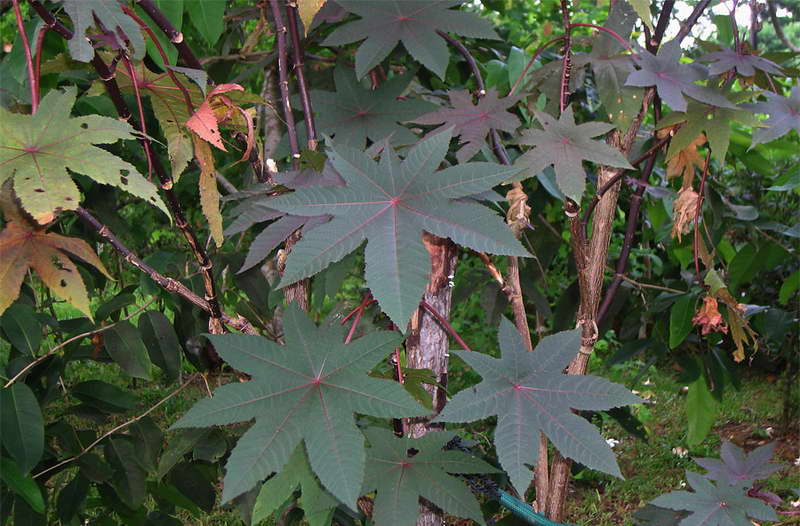

Castor oil plant Ricinus borboniensis photo
Reaches a height of 3 m. The trunk is dense, slightly woody. The leaves are mostly green. The leaf plates located at the tops of the shoots near the inflorescences have a burgundy hue.
Castor oil Kazachka
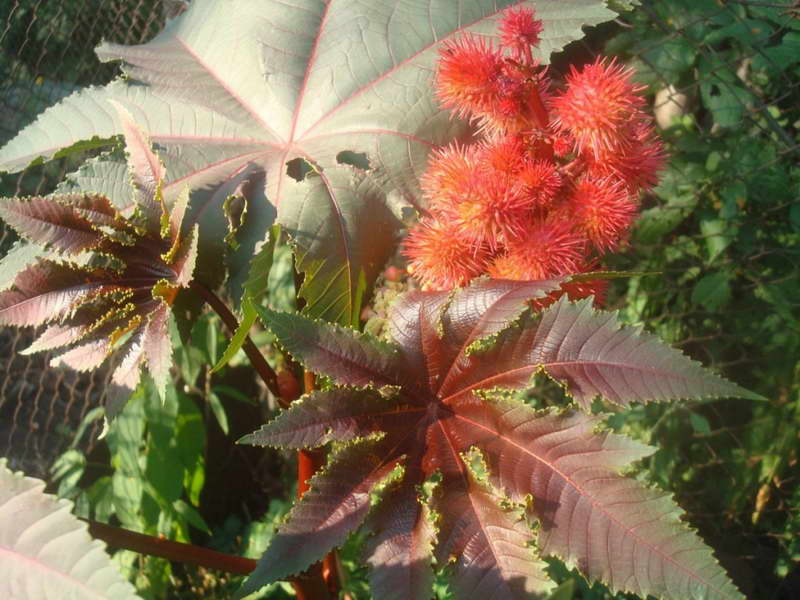

Kleshchevin Kazachka photo
Domestic variety. Plant height is 2 m. The stem is colored red-brown. Young leaves have a reddish-purple hue with interspersed white, but over time they turn dark green with reddish veins. The color of the flowers is blood red, the seed pods are also bright purple in color.
Castor oil plant bronze
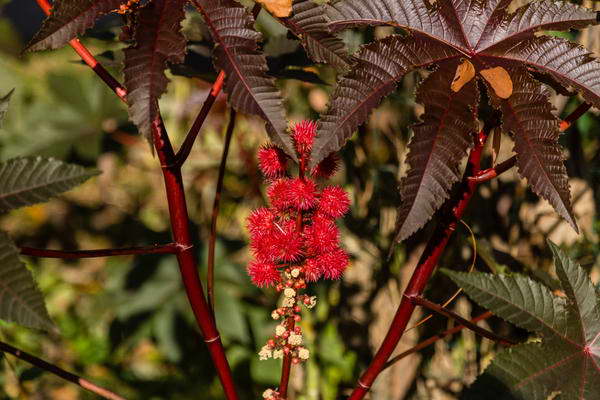

Castor oil plant bronze palm photo
The leaves and shoots of the plant have a bronze tint, a real bronze palm tree in your flower garden!
Castor oil purpurea
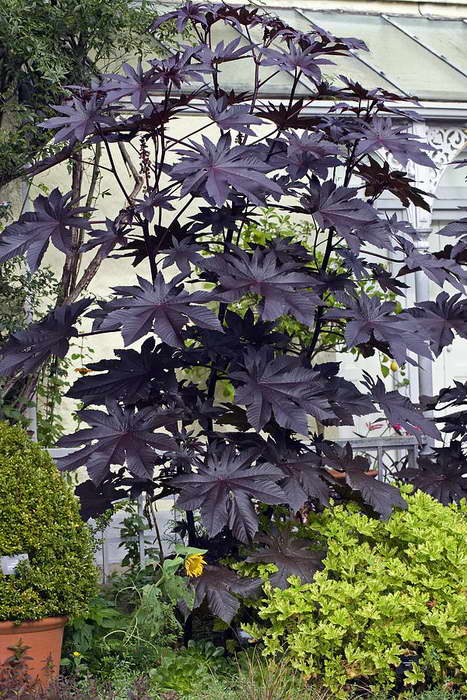

Castor bean purple cultivar Ricinus Communis new Zealand Purple photo
A rare curiosity for our gardens, such an annual palm tree looks fantastic. It should be planted in your flower garden or in a free corner of the garden.
Wintering, collecting seeds
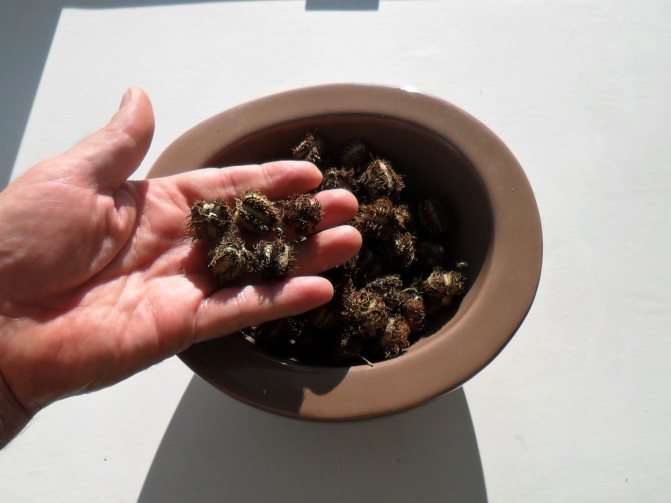

Castor oil, regardless of the variety in the climatic conditions of Russia, is grown only as an annual crop, therefore, transplanting and preparation for wintering is not required. In autumn, after the onset of the first cold weather, the shoots begin to darken, and the leaves quickly wither. A dried plant must be cut to the very root, dug into the ground or thrown into a compost pit.
When growing castor bean in a sunny area, large seed pods have time to ripen before the onset of cold weather.The seed can be trimmed and placed in a dry, warm room. In this state, they need to be stored for 1-2 months (approximately until the beginning of December), after which the seeds should be removed and set aside for planting for the next season. Planting material remains viable for 3-4 years.
Variety selection
It has already been said that the castor oil plant is unique in its genus, however, the breeders have done the necessary work and now gardeners can choose a variety according to their preferences.
- The Zanzibar castor oil plant is an annual of medium height (only two meters). Its stem is covered with beautiful and large red-purple leaves. Cultivation of Zanzibar castor bean from seeds is popular for its beautiful inflorescences, which is rare for this plant.
- Cambodian is perhaps the smallest variety, since the tallest plant reached only one meter and twenty centimeters. She has a rather original black barrel. The flowerbed looks beautiful, where the Cambodian castor oil plant grows along with other varieties.
- Gibson's castor oil when grown from seeds reaches a height of one and a half meters. It differs from other varieties in that its leaves have a metallic sheen.
- Borbonne. A common species in our latitudes. It has a high red trunk, large green and shiny leaves.
Castor oil plant, or ricinus communis, or the tree of paradise, is native to Africa. The climate of those regions allows the plant to reach a height of up to 10 m.
Castor oil plant is a thermophilic perennial plant, but in Russia it grows only as an annual.
The peculiarities of development are associated with the fact that with such harsh winters, the paradise tree simply does not have a chance to survive.
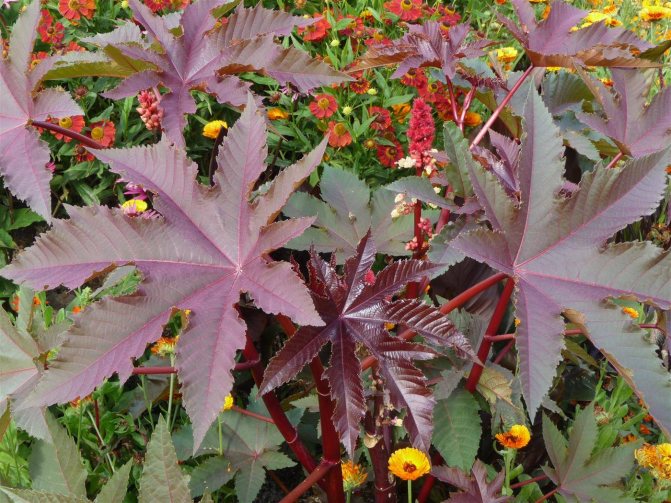

In our country, it is a shrub with a height of 2 m.
The leaves can be up to 30-80 cm wide. They have pronounced veins, usually green, but depend on the variety. Blooms in dense inflorescences.
After that, oval fruits with thorns are formed on the plant. Each of them is approximately 3 cm in diameter.
Castor oil plant is an oil plant. It has medicinal properties. If we talk about species, then there is only one - castor oil plant.
In addition, many different varieties can be seen. All of them are slightly different in appearance, have greener, purple or reddish leaves.
Further popular varieties of castor oil plants in the photo.
The castor oil plant of Zanzibar is a shrub that reaches a height of 2 m. The palmate-separated leaves are huge. Their color is red and purple.
Gibson's castor oil plant is a compact plant. The shrub reaches a height of only 50 cm. The leaves are dark green, with burgundy veins.
In addition, the sheet plates have an interesting metallic sheen. There are purple leaf colors.
Castor bean Cambodian, unlike the Zanzibar variety, can grow up to 1.2 m tall. It is also often called Indian. The leaves of the plant are dark green, and the trunk is almost black.
Castor oil Bourbon is a taller plant, up to 3 m. The trunk of the plant becomes lignified over time. The leaves are different in color, they are green in the center, and burgundy at the edges.
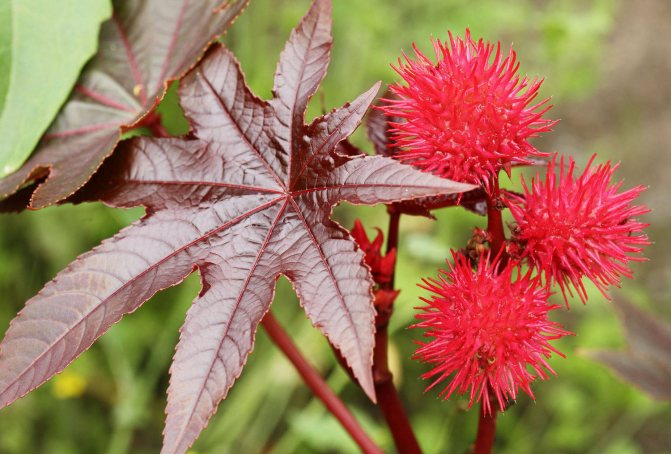

Castor oil purpurea is very rare in household plots. The annual plant has a unique leaf color. They are large and purple.
Castor oil Impala forms bright red inflorescences during flowering. The shrub reaches a height of 1.2 m. The leaves are veined in red, the leaf plates themselves are green-bronze.
And this is not the whole list of interesting plant varieties. For example, the Oracle castor bean is capable of changing the color of the leaves. It depends on the lighting and the age of the shrub.
Red castor bean varieties are distinguished by the dark red color of the leaf plates. These include the castor bean variety Hot Heart.
And also there is a unique bronze castor oil plant. Its leaves are bronze in color, such a plant will become a real highlight of the whole garden.
Problems and solutions
During particularly hot and dry periods, dry or yellowed spots may appear on castor bean leaves. This means that the plant suffers from a lack of moisture. In addition to abundant watering, it is necessary to spray in the morning or evening in order to save the affected specimen from death.
Castor oil plants at a young age can be very annoying weeds. Weeding at this time should be a mandatory point of care, otherwise the bush will grow slowly and look depressed. After its growth exceeds 0.5 m, the plant will find enough of its own strength to survive.
No treatment for castor bean pests is required, since it is not affected by pests. The same cannot be said for diseases and infections. To eliminate troubles, it is advisable to treat the plant with Bordeaux liquid for the purpose of prophylaxis at the very beginning of its active growth.
Specialized medical care
There is no specific antidote that stops the destructive effects of castor bean toxic substances. In case of poisoning, the following measures are taken:
- blood transfusion - a blood transfusion procedure;
- infusion of antispasmodics, anesthetics that reduce pain in the abdomen;
- oxygen therapy for cell regeneration;
- taking diuretics to stimulate renal activity.


After the main measures, symptomatic treatment is prescribed. Its effectiveness, like all resuscitation measures in general, depends on the intensity of damage to the tissues of internal organs.
Poisoning symptoms
The main danger is the secrecy of symptoms, they appear with such a delay in time that it is not always easy to determine the connection between a poisonous plant and poisoning. Therefore, adults cannot say why they feel so bad, let alone children. Specific symptoms make themselves felt in a day, or even later.
If particles of castor beans enter the stomach, symptoms of intoxication will appear within a day. Worsening of the condition will begin with a strong burning sensation in the throat and continue with the following symptoms:
- nausea and increased vomiting, sometimes with blood;
- acute abdominal pain;
- diarrhea, sometimes black;
- blood from the anus.
Further, such dangerous symptoms will occur:
- lowering blood pressure;
- weakening and increased heart rate;
- prostration;
- intense head pain;
- thirst and dry mouth.
When toxins enter the body through the patient's lungs, coughing with blood secretions begins to torment, breathing becomes difficult, and there is not enough oxygen. Severe damage from castor oil plants is often accompanied by hallucinations, delirium, disorientation, and impaired coordination. One of the characteristic symptoms of ricin intoxication is multiple effusion of blood in the retina.
If medical assistance is not provided in a timely manner, the condition will deteriorate rapidly. The work of the kidneys will be disrupted, bleeding in the lungs will begin. Cerebral hemorrhage with loss of consciousness often occurs. Therefore, without qualified assistance, collapse and death occurs in a week.
First aid for castor oil poisoning
To reduce the concentration of toxic potent substances in the body, it is necessary to rinse the stomach as soon as possible. Artificially provoke vomiting after drinking at least 1 liter of water. Further, it is recommended to take drugs with sorbing properties:
- activated carbon - 1 tablet for every 10 kg of weight;
- Polysorb;
- Smecta;
- Enterosgel, etc.
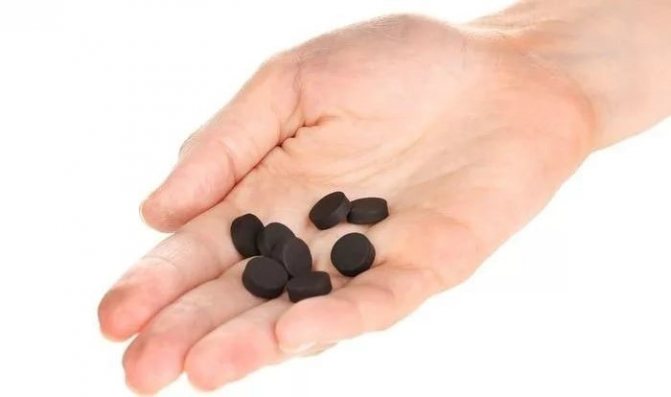

Sodium bicarbonate solution is often used as a sorbent.
First aid and specificity of treatment
In case of poisoning with ricinus toxins, priority measures of assistance should be directed at stopping the spread of toxins in the blood and quickly transporting the victim to a medical center for qualified treatment.At home, before the arrival of doctors, the patient must be provided with all possible help to anyone:
- give the patient a lot of drink, provoke vomiting;
- give an absorbent (activated carbon);
- to protect the mucous membrane of the digestive system, jelly decoctions, starch are used.
The patient needs bed rest and complete rest. How high-quality the first aid measures will be for the patient is a matter of life and death. According to statistics, with competent timely actions, a fatal outcome does not happen more often than 2% - versus 7% without such.
There are no antidotes for castor bean toxins yet. His medical developments are still far from successful. Therefore, all subsequent medicinal assistance will serve to cleanse the patient's blood, relieve dangerous symptoms and stop the development of poisoning. The following medical measures can be useful for this:
- blood transfusion (blood transfusion);
- multiple bowel cleansing;
- the introduction of analgesics, since the pain is very strong;
- to enhance the functionality of the kidneys, the patient is given diuretics;
- oxygen therapy.
During treatment, the patient is under constant medical supervision. However, if the patient managed to save life, most often it is not possible to save the working capacity of individual organs.
Chemical composition
Castor oil contains a number of chemicals that make the plant useful, but also cause the presence of poisonous properties. The composition includes:
- glycerol;
- essential oils;
- fatty acids - oleic, ricinoleic, linoleic.
Castor bean contains alkaloids:
- ricin - in the shell of the fruit (the most poisonous part);
- ricinin (ricin derivative) - in seeds, leaves, cake, flowers.
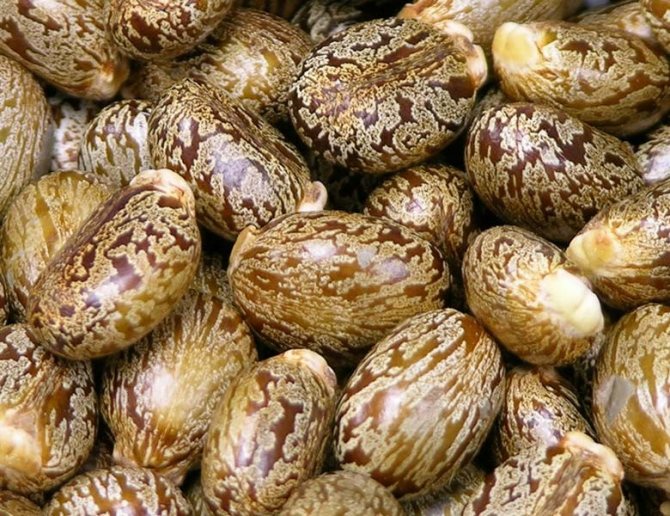

These substances belong to the cyano group. The level of their toxicity in its pure form is more than 5 times higher than the corresponding indicators of potassium cyanide.
After flowering
Seed collection


In the event that you decide to collect seeds from the plants you grow, then in the summer, mark those bushes that look the most impressive, are absolutely healthy and powerful. In the first days of September, you need to trim the fruits and fold them to dry in a well-ventilated room. The seed pods will dry only in November or December. If the fruits dry very well, then with slight pressure they should completely crumble, and at the same time 2 or 3 seeds will fall out of them, which are outwardly similar to beans. Remember that you must wear gloves when working with castor bean fruits and seeds. These seeds must be stored in a place where children or animals cannot reach them. They remain viable for at least four years.
Composition and useful properties
The benefits and harms of castor bean are due to its unique chemical composition. This plant contains fatty acids that give medicinal properties from its parts. Poisonous substances such as ricin and ricinin are also present. In addition, glycerin and a set of useful minerals can also be noted.
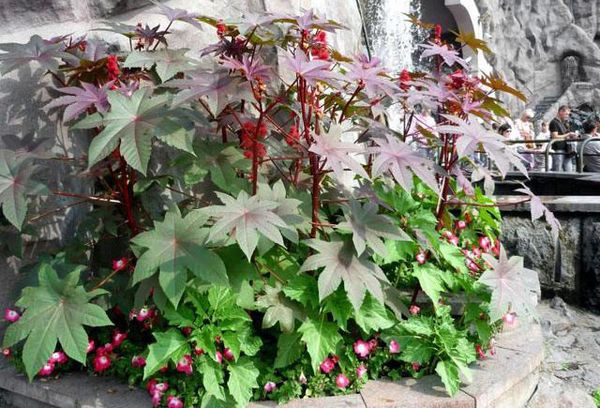

For medicinal purposes, not the castor oil itself is used, but the castor oil obtained from it. In the process of its production, toxic elements decompose, but this does not mean that the product can be used uncontrollably and at the very first need. Here are the main indications for using castor oil:
- The need to cleanse the intestines. The product is considered to be a safe and effective laxative that acts mildly on the intestines due to its plant origin. The desired effect occurs 4-6 hours after taking the medicine. However, it is worth considering that long-term intake of castor oil (more than 3 days) can irritate the intestinal mucosa and cause dehydration.
Tip: When buying castor oil, preference should be given to products placed in dark glass bottles.If the condition is not met, the effectiveness of such a composition will be questionable. Castor oil can also be bought in capsules, this form of the product will retain its properties for years.
- According to a number of experts, castor oil has a pronounced anthelmintic effect.
- In rare cases, castor oil in the form of castor oil is used to stimulate labor.
- The product also increases the effectiveness of topical products, so some of them are used in combination with castor oil.
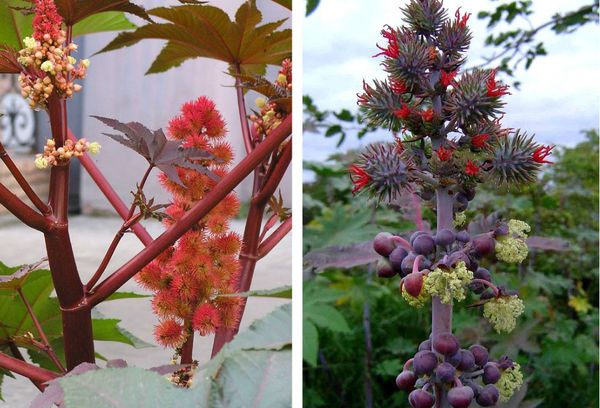

The use of castor oil plant for therapeutic or prophylactic purposes should be agreed with the doctor. The product is quite specific and active, so the appearance of side effects or a negative reaction of the body is not excluded.
Harm and benefit
The substances that make up castor bean are widely used by physicians as an effective ruminator. It is also effective during childbirth, as it strengthens the uterine muscles, and has the ability to induce severe labor pains.
Medical castor oil is famous for its especially strong effect. There is so much of it in castor seeds that technical varieties of this oil are used in industry: aircraft construction, the manufacture of lubricants, soaps, the creation of varnishes and paints. As for pharmaceuticals, seed oils are included in many healing ointments, powerful throat aids, and medications prescribed for urolithiasis.
In addition, castor oil serves as a powerful healing agent for damage to the integumentary or internal tissues. It is also used as a cosmetic product. Traditional healers use seed oils for contraception and for the prevention of tumor pathologies.

